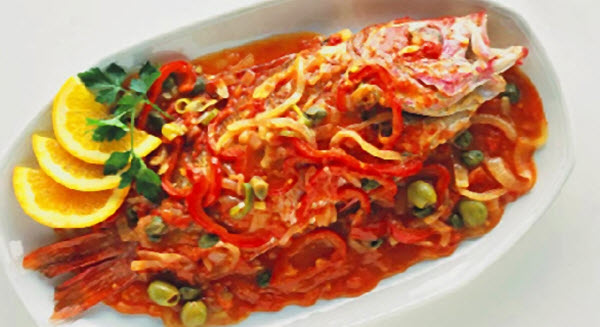Huachinango a la Veracruzana

The state of Veracruz has a significant share of the nations Gulf of Mexico coastline and has had an important port for centuries. This port brought cargo, European sailors and African slaves to Veracruz and the state is known for its blend of international influences and mixed ethnic populations. Even though Veracruz is not considered a part of the Caribbean, it had strong ties to other Caribbean ports and this is clearly visible in the heritage of the state.
The cuisine of Veracruz is an eclectic array formed by both native and imported food products and spices. The recipe below is a good example. The red snapper is native to the Gulf of Mexico, the word tomato comes from the Nahuatl (Aztec language) word tomatl, and jalapeño actually means “from Jalapa”, a city in Veracruz where this pepper was traditionally cultivated.
Olives, raisins, parsley, capers, garlic and onions are commonplace in Mediterranean cuisine, and it was the Spanish that introduced citrus fruit to Mexico. The black pepper is on the other hand a southern India native that arrived in Veracruz as a result of the global spice trade during Age of Sails.
So, what about the potato? The truth is that we don’t know much about its early history in Mexico. Populations of wild potato plants indicate that Mexico lies within the potato’s area of origin, but unlike the peoples of the Andes, the pre-Columbian inhabitants of Mexico left no traces of potato cultivation. No illustrations of potatoes have been found in any of the surviving copies of the sixteenth century Aztec Codices. It has been proposed that potato cultivation was introduced to Mexico by European shippers that wanted to be able to obtain these nutritious tubers in Mexican ports before leaving for long voyages.
Recipe for Huachinango a la Veracruzana (yields 8 servings)
Ingredients
- Approximately 6 pounds of whole gutted red snapper
- 1 teaspoon of coarse salt
- Ordinary table salt to taste
- 1 teaspoon of freshly ground black pepper
- 1/2 cup of freshly squeezed lime juice
- 1/2 cup of olive oil
- 2 medium-size yellow onions, diced
- 6 garlic cloves, minced
- 6 pounds of tomatoes, diced
- 1 cup green olives, pitted
- 1/2 cup of Spanish capers
- 1/2 cup of black raisins
- 1 teaspoon of canned pickled jalapeño chiles, sliced
- 4 dried bay leaves
- 1/2 pound of new potatoes, peeled, blanched, and sliced
- 1/4 cup coarsely chopped fresh flat-leaf parsley
Instructions
- Place the snappers in a dish.
- Mix together lime juice, coarse salt and black pepper to form a marinade, and pour it over the snappers. Cover the dish with a lid or plastic wrap, and leave in the fridge for one hour.
- Prepare all the ingredients that require preparation, i.e. dice the onions, mince the garlic, dice the tomatoes, prepare the potatoes, and so on.
- It is now time to make the sauce. Heat the olive oil over moderate heat in a Dutch oven. The oil should be hot but not smoking.
- Place onion in the olive oil and add table salt to taste. Cover and let the onion sweat until it becomes translucent. (It will usually take about 2 minutes if the temperature is right.)
- Add garlic and sauté briefly, before adding the tomatoes. Check if the fish needs more salt.
- Cover and cook until the tomatoes change color. Then it is time to lower the heat and add olives, capers, raisins, jalapeños, and bay leaves.
- Simmer under cover until the sauce thickens. This will usually take 10 – 15 minutes. In the mean time, preheat your oven to 350 degrees F.
- Remove the bay leaves from the sauce.
- Pour ½ cup of sauce into an ovenproof dish. Remove the snappers from the marinade and place them on top of the sauce. Pour the remaining sauce over the fish. Scatter the sliced potatoes on top.
- Cover the fish and bake in the oven until the fish can be easily flaked with a fork. This will usually take about 45 minutes in 350 degrees F.
- Garnish with parsley before serving.
This dish is traditionally served with rice. Veracruz role as an important port town made corn a less dominant staple here than in most other parts of Mexico.